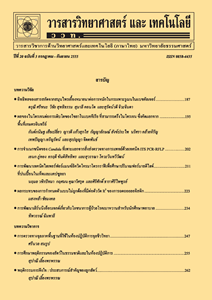อิทธิพลของปริมาณน้ำในสารละลายอิเล็กโทรไลท์ต่อโครงสร้างของท่อนาโนไทเทเนียมไดออกไซด์ที่เตรียมโดยการแอโนไดเซชัน
Main Article Content
Abstract
Titanium dioxide nanotubes (TNTs) were prepared from titanium (Ti) plate by anodization with varying proportions of water (0-20 wt%) mixed in glycerol (GR), and fixed NH4F concentration at 2.5 wt% as electrolyte. Anodization process was carried out at potentiostatic of 30 V for 60 min of all samples. The surface morphology and crystal structure of TNTs were investigated by field emission scanning electron microscopy (FE-SEM) and X-ray diffraction (XRD), respectively. The results showed that the increase of diameter and decrease of density of TNTs were strongly depended on the increase of water proportion. The crystal structure of TNTs was slightly changed from Ti to TiO when adding water in the electrolyte solution. These results were affected from an increase of current density by ionized water during anodization process when increasing water mixture in GR. Moreover, the increase of water affected the increase of water drop angle on TNTs surface, which showed hydrophobic property of the surface.
Article Details
References
[2] Escada, A.L., Nakazato, R.Z., Claro, A.P.R.A., Escada, A.L., Nakazato, R.Z., Yin, H., Liu, H. and Shen, W.Z., 2017, Influence of anodization parameters in the TiO2 nanotubes formation on Ti-7.5Mo alloy surface for biomedical application, Mater. Res. 21(3): 035601.
[3] Oh, S. and Jin, S., 2006, Titanium oxide nanotubes with controlled morphology for enhanced bone growth, Mater. Sci. Eng. 26: 1301-1306.
[4] Ishizaki, T., Saito, N. and Takai, O., 2010, Correlation of cell adhesive behaviors on superhydrophobic, superhydrophilic, and micropatterned superhydrophobic/super hydrophilic surfaces to their surface chemistry, Surf. Sci. 26: 8147-8154.
[5] Sreekantan, S., Saharudin, K.A., Lockman, Z. and Tzu, T.W., 2010, Fast-rate formation of TiO2 nanotube arrays in an organic bath and their applications in photocatalysis, Nanotechnology 21: 56-79.
[6] Tsuchiya, H., Macak, J., Taveira, L., Balaur, E., Ghicov, A., Sirotna, K. and Schmuki, P., 2005, Self-organized TiO2 nanotubes prepared in ammonium fluoride containing acetic acid electrolytes, Electrochem 7: 576-580.
[7] Alivov, Y., Pandikunta, M., Nikishin, S. and Fan, Z., 2009, The anodization voltage influence on the properties of TiO2 nanotubes grown by electrochemical oxidation, Nanotechnology 20: 63-90.
[8] Li, S., Zhang, G., Guo, D., Yu, L. and Zhang, W., 2009, Anodization fabrication of highly ordered TiO2 nanotubes, Phys. Chem. 113: 12759-12765.
[9] Hassan, F.M.B., Nanjo, H., Kanakubo, M., Ishikawa, I. and Nishioka, M., 2009, Effect of ultrasonic waves on the formation of TiO2 nanotubes by electrochemical anodization of titanium in glycerol and NH4F, Surf. Sci. Nanotech. 7: 84-88.
[10] Yoriya, S., Mor, G., Sharma, S. and Grimes, C., 2008, Synthesis of ordered arrays of discrete, partially crystalline titaniananotubes by Ti anodization using diethylene glycol electrolytes, Mater. Chem. 18: 3332-3336.
[11] Kubiak, K., Wilson, M.C.T., Mathia, T. and Carval, P., 2011, Wettability versus roughness of engineering surface, Surf. Sci. 271: 523-528.
[12] Hossain, F. and Ahosan, S., 2015, Investigation of NH4F concentration effects on TiO2 nanotube arrays fabricated by anode oxidation method, Thin Solid Films 517: 561-566.
[13] Sreekantan, S., Lockman, Z., Hazan, R., Tasbihi, M., Tong, L., Lee, K. and Mohamed, A.R., 2009, Influence of electrolyte pH on TiO2 nanotube formation by Ti anodization, J. Alloys Comp. 485: 478-483.
[14] Simi, V.S. and Rajendran, N., 2017, Influence of tunable diameter on the electrochemical behavior and antibacterial activity of titania nanotube arrays for biomedical applications, Mater. Charact. 129: 67-79.
[15] Yin, H., Liu, H. and Shen, W.Z., 2010, The large diameter and fast growth of self-organized TiO2 nanotube arrays achieved via electrochemical anodization, Nanotechnology 21: 035601.
[16] Yang, W., Peng Q., Chen, R., Wen, Y., Shab, B., 2013, Correlation between hydrophilicity and surface aggregation in anodized TiO2 nanotube arrays, Phys. Proc. 48: 220-227.
[17] Lorenzetti, M., Bernardini, G., Luxbacher, T., Santucci, A., Kobe, S. and Novask, S., 2016, Electrokinetic properties of TiO2 nanotubular surfaces, Nanoscale Res. Lett. 11: 378.
[18] Yu, W.Q., Jiang X.Q. and Xu, L., 2010, The effect of anatase TiO2 nanotube layers on MC3T3-E1 preosteoblast adhesion, proliferation and differentiation, J. Biomed. Mater. 94: 1012-1022.
[19] Narayanan, R., Kwon, T.Y. and Kim, K.H., 2009, Anodic TiO2 from stirred Na2SO4 /NaF electrolytes: Effect of applied voltage and stirring, Mater. Lett. 63: 2003-2006.
[20] Khudhair, D., Amani, H., Gaburro, J., Shafei, S., Garmestani, H. and Bhatti, A., 2017, Enhancement of electro-chemical properties of TiO2 nanotubes for biological interfacing, Mater. Sci. Eng. 77: 111-120.
[21] Bhushan, B. and Jung, Y.C., 2011, Natural and biomimetic artificial surfaces for superhydrophobicity, self-cleaning, low adhesion, and drag reduction, Prog. Mater. Sci. 56: 1-108.
[22] Ye, J., Yin, Q. and Zhou, Y., 2009, Superhydrophilicity of anodic aluminum oxide, Thin Solid Films 517: 6012-6015.


